Dual inhibition of EGFR and MET induces synthetic lethality in triple-negative breast cancer cells through downregulation of ribosomal protein S6
- Authors:
- Yong Weon Yi
- Kyusic You
- Edward Jeong Bae
- Sahng-June Kwak
- Yeon-Sun Seong
- Insoo Bae
-
Affiliations: Department of Nanobiomedical Science and BK21 PLUS Research Center for Regenerative Medicine, Dankook University, Cheonan, Republic of Korea, Department of Biochemistry, College of Medicine, Dankook University, Cheonan, Republic of Korea - Published online on: May 4, 2015 https://doi.org/10.3892/ijo.2015.2982
- Pages: 122-132
This article is mentioned in:
Abstract
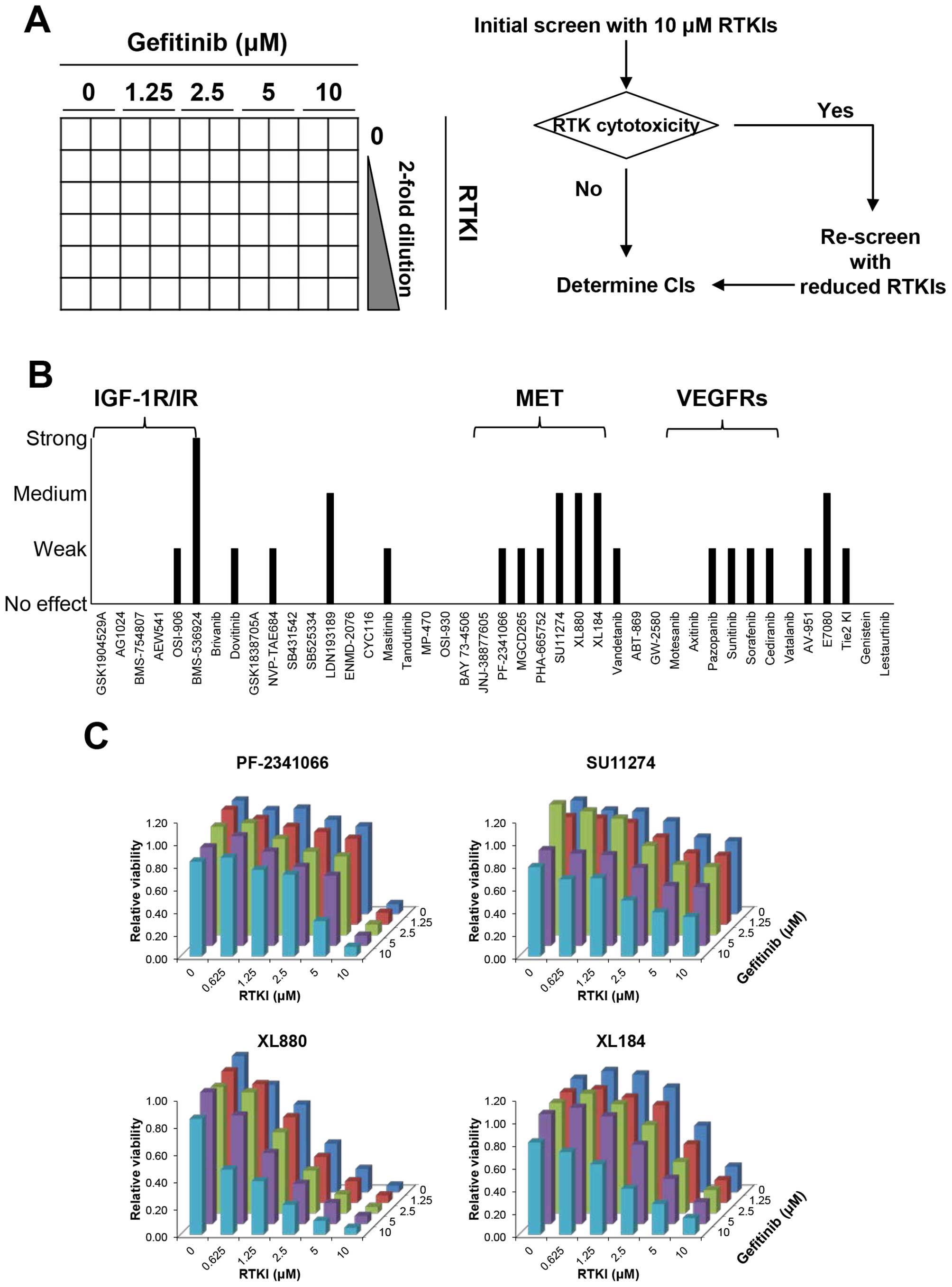 |
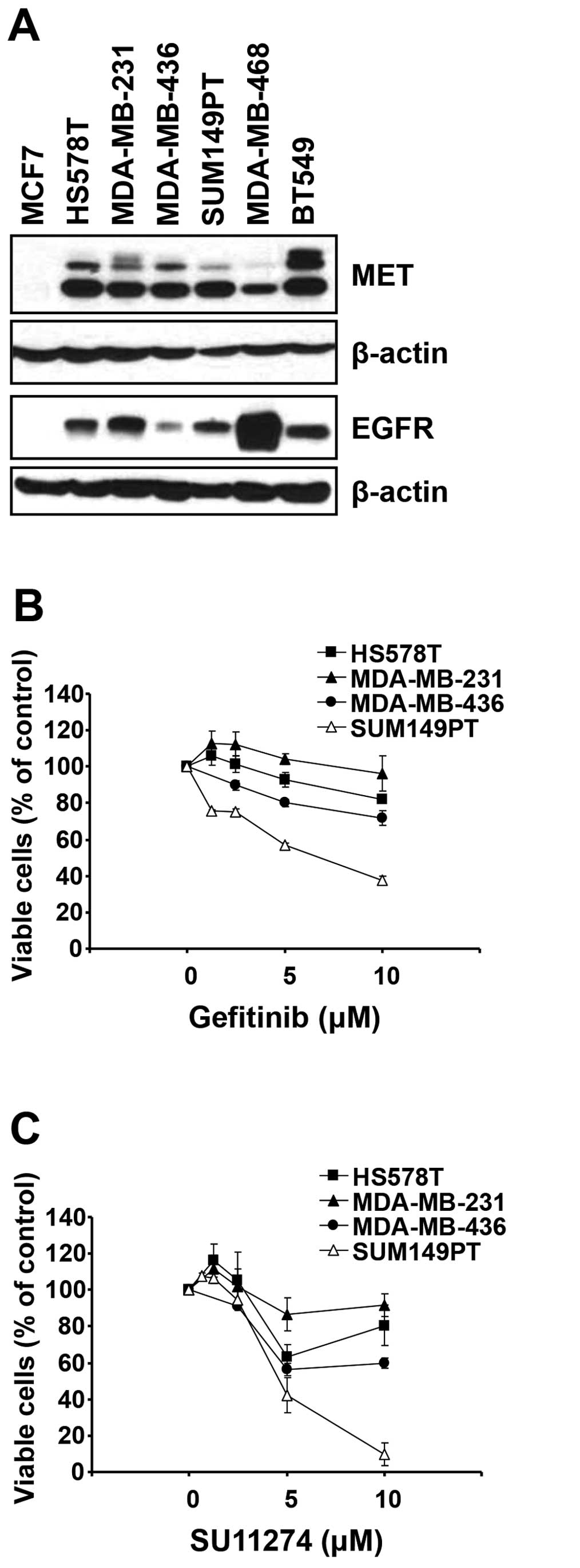 |
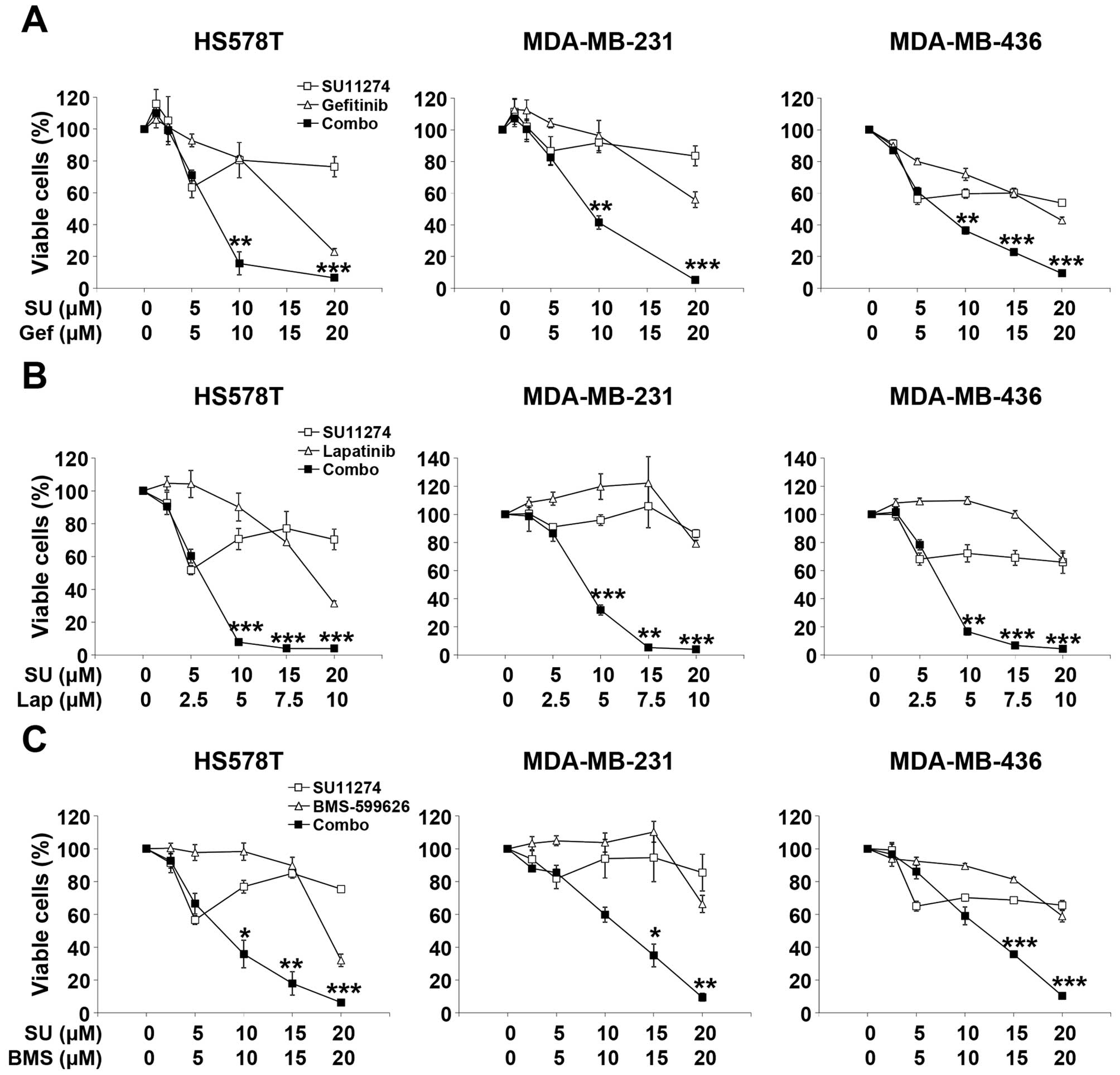 |
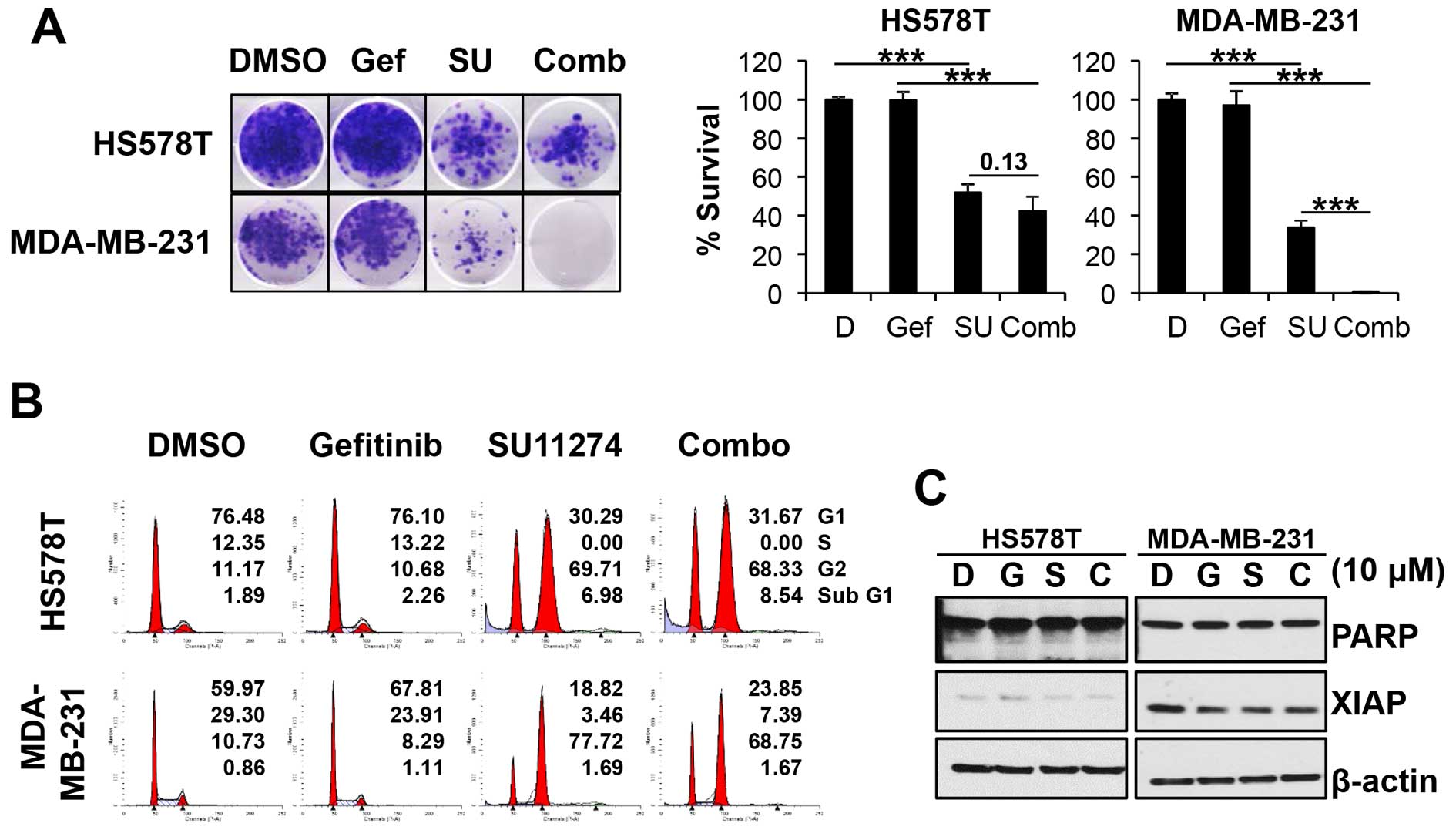 |
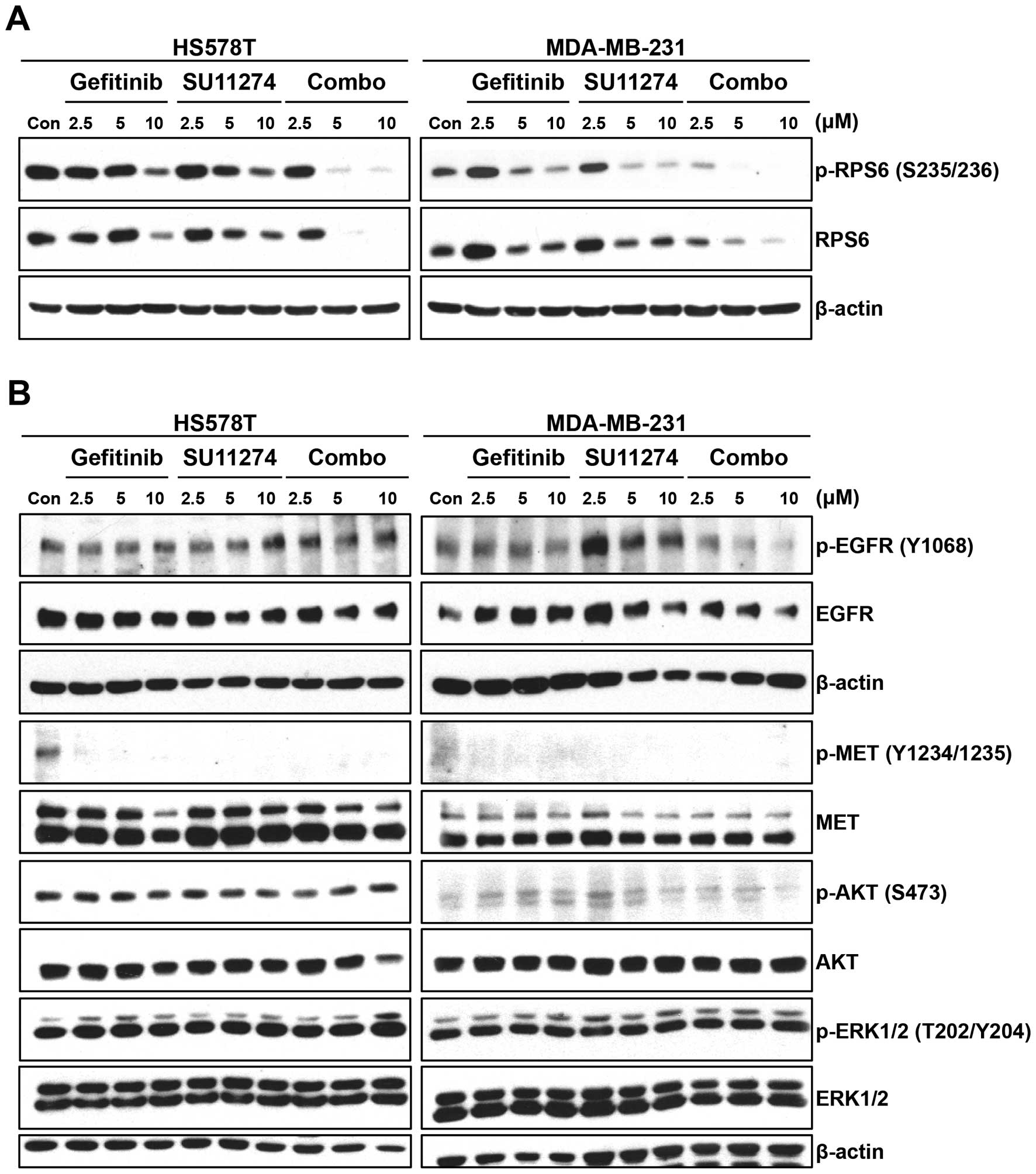 |
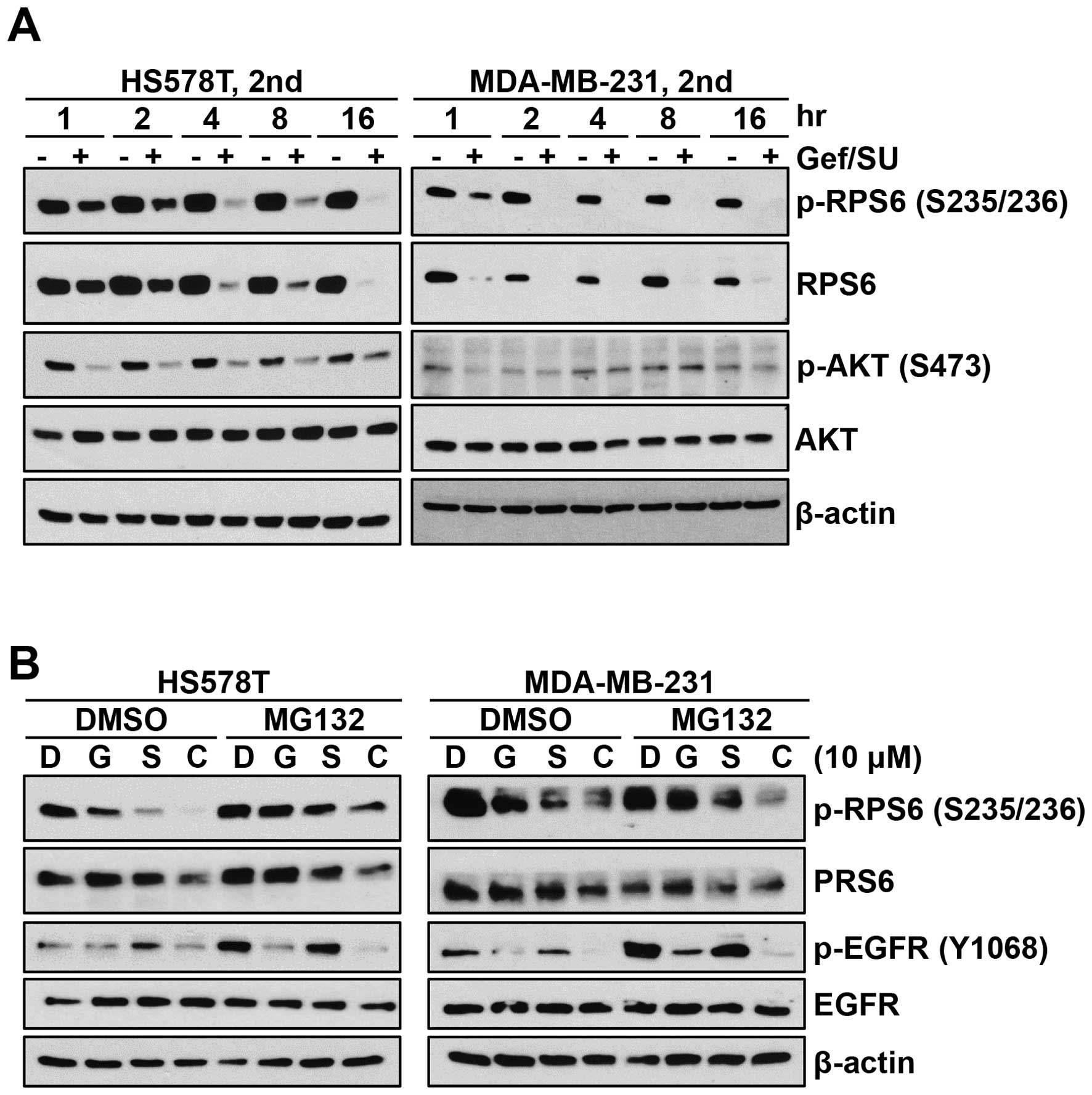 |
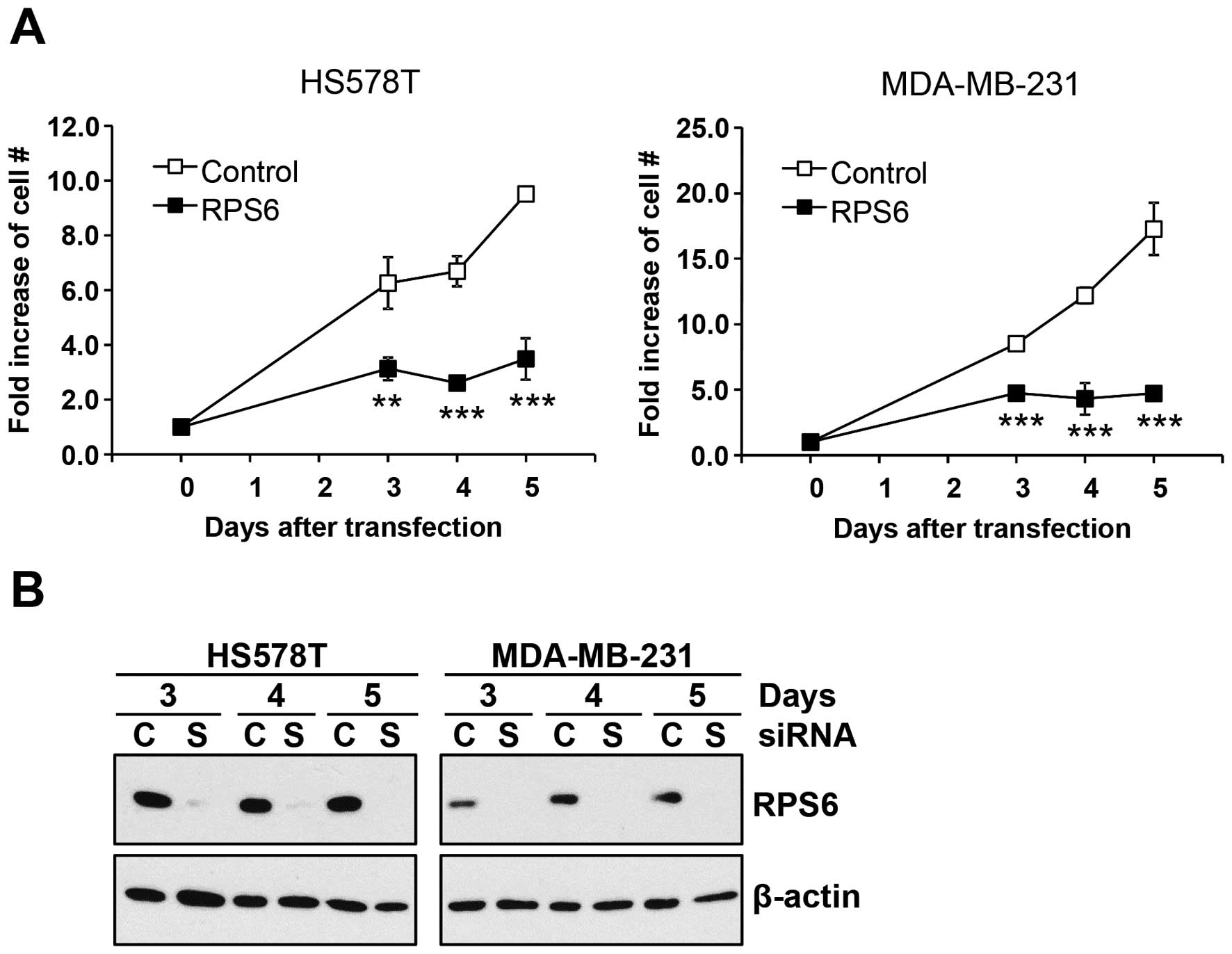 |
|
Siegel R, Ma J, Zou Z and Jemal A: Cancer statistics, 2014. CA Cancer J Clin. 64:9–29. 2014. View Article : Google Scholar : PubMed/NCBI | |
|
Lehmann BD, Bauer JA, Chen X, Sanders ME, Chakravarthy AB, Shyr Y and Pietenpol JA: Identification of human triple-negative breast cancer subtypes and preclinical models for selection of targeted therapies. J Clin Invest. 121:2750–2767. 2011. View Article : Google Scholar : PubMed/NCBI | |
|
Morris GJ, Naidu S, Topham AK, Guiles F, Xu Y, McCue P, Schwartz GF, Park PK, Rosenberg AL, Brill K, et al: Differences in breast carcinoma characteristics in newly diagnosed African-American and Caucasian patients: A single-institution compilation compared with the National Cancer Institute’s Surveillance, Epidemiology, and End Results database. Cancer. 110:876–884. 2007. View Article : Google Scholar : PubMed/NCBI | |
|
Irvin WJ Jr and Carey LA: What is triple-negative breast cancer? Eur J Cancer. 44:2799–2805. 2008. View Article : Google Scholar : PubMed/NCBI | |
|
Liedtke C, Mazouni C, Hess KR, André F, Tordai A, Mejia JA, Symmans WF, Gonzalez-Angulo AM, Hennessy B, Green M, et al: Response to neoadjuvant therapy and long-term survival in patients with triple-negative breast cancer. J Clin Oncol. 26:1275–1281. 2008. View Article : Google Scholar : PubMed/NCBI | |
|
Podo F, Buydens LM, Degani H, Hilhorst R, Klipp E, Gribbestad IS, Van Huffel S, van Laarhoven HW, Luts J, Monleon D, et al: FEMME Consortium: Triple-negative breast cancer: Present challenges and new perspectives. Mol Oncol. 4:209–229. 2010. View Article : Google Scholar : PubMed/NCBI | |
|
Eccles SA: The epidermal growth factor receptor/Erb-B/HER family in normal and malignant breast biology. Int J Dev Biol. 55:685–696. 2011. View Article : Google Scholar : PubMed/NCBI | |
|
Yarden Y and Pines G: The ERBB network: At last, cancer therapy meets systems biology. Nat Rev Cancer. 12:553–563. 2012. View Article : Google Scholar : PubMed/NCBI | |
|
Reis-Filho JS, Milanezi F, Carvalho S, Simpson PT, Steele D, Savage K, Lambros MB, Pereira EM, Nesland JM, Lakhani SR, et al: Metaplastic breast carcinomas exhibit EGFR, but not HER2, gene amplification and overexpression: Immunohistochemical and chromogenic in situ hybridization analysis. Breast Cancer Res. 7:R1028–R1035. 2005. View Article : Google Scholar : PubMed/NCBI | |
|
Reis-Filho JS, Pinheiro C, Lambros MB, Milanezi F, Carvalho S, Savage K, Simpson PT, Jones C, Swift S, Mackay A, et al: EGFR amplification and lack of activating mutations in metaplastic breast carcinomas. J Pathol. 209:445–453. 2006. View Article : Google Scholar : PubMed/NCBI | |
|
Livasy CA, Karaca G, Nanda R, Tretiakova MS, Olopade OI, Moore DT and Perou CM: Phenotypic evaluation of the basal-like subtype of invasive breast carcinoma. Mod Pathol. 19:264–271. 2006. View Article : Google Scholar | |
|
Nielsen TO, Hsu FD, Jensen K, Cheang M, Karaca G, Hu Z, Hernandez-Boussard T, Livasy C, Cowan D, Dressler L, et al: Immunohistochemical and clinical characterization of the basal-like subtype of invasive breast carcinoma. Clin Cancer Res. 10:5367–5374. 2004. View Article : Google Scholar : PubMed/NCBI | |
|
Lehmann BD and Pietenpol JA: Identification and use of biomarkers in treatment strategies for triple-negative breast cancer subtypes. J Pathol. 232:142–150. 2014. View Article : Google Scholar : | |
|
Dawson SJ, Provenzano E and Caldas C: Triple negative breast cancers: Clinical and prognostic implications. Eur J Cancer. 45(Suppl 1): 27–40. 2009. View Article : Google Scholar : PubMed/NCBI | |
|
Lakhani SR, Reis-Filho JS, Fulford L, Penault-Llorca F, van der Vijver M, Parry S, Bishop T, Benitez J, Rivas C, Bignon YJ, et al: Prediction of BRCA1 status in patients with breast cancer using estrogen receptor and basal phenotype. Clin Cancer Res. 11:5175–5180. 2005. View Article : Google Scholar : PubMed/NCBI | |
|
Cheang MC, Voduc D, Bajdik C, Leung S, McKinney S, Chia SK, Perou CM and Nielsen TO: Basal-like breast cancer defined by five biomarkers has superior prognostic value than triple-negative phenotype. Clin Cancer Res. 14:1368–1376. 2008. View Article : Google Scholar : PubMed/NCBI | |
|
Rakha EA, El-Sayed ME, Green AR, Lee AH, Robertson JF and Ellis IO: Prognostic markers in triple-negative breast cancer. Cancer. 109:25–32. 2007. View Article : Google Scholar | |
|
Tischkowitz M, Brunet JS, Bégin LR, Huntsman DG, Cheang MC, Akslen LA, Nielsen TO and Foulkes WD: Use of immunohistochemical markers can refine prognosis in triple negative breast cancer. BMC Cancer. 7:1342007. View Article : Google Scholar : PubMed/NCBI | |
|
Baselga J, Gómez P, Greil R, Braga S, Climent MA, Wardley AM, Kaufman B, Stemmer SM, Pêgo A, Chan A, et al: Randomized phase II study of the anti-epidermal growth factor receptor monoclonal antibody cetuximab with cisplatin versus cisplatin alone in patients with metastatic triple-negative breast cancer. J Clin Oncol. 31:2586–2592. 2013. View Article : Google Scholar : PubMed/NCBI | |
|
Bernsdorf M, Ingvar C, Jörgensen L, Tuxen MK, Jakobsen EH, Saetersdal A, Kimper-Karl ML, Kroman N, Balslev E and Ejlertsen B: Effect of adding gefitinib to neoadjuvant chemotherapy in estrogen receptor negative early breast cancer in a randomized phase II trial. Breast Cancer Res Treat. 126:463–470. 2011. View Article : Google Scholar : PubMed/NCBI | |
|
Carey LA, Rugo HS, Marcom PK, Mayer EL, Esteva FJ, Ma CX, Liu MC, Storniolo AM, Rimawi MF, Forero-Torres A, et al: TBCRC 001: Randomized phase II study of cetuximab in combination with carboplatin in stage IV triple-negative breast cancer. J Clin Oncol. 30:2615–2623. 2012. View Article : Google Scholar : PubMed/NCBI | |
|
Anderson NG, Ahmad T, Chan K, Dobson R and Bundred NJ: ZD1839 (Iressa), a novel epidermal growth factor receptor (EGFR) tyrosine kinase inhibitor, potently inhibits the growth of EGFR-positive cancer cell lines with or without erbB2 overexpression. Int J Cancer. 94:774–782. 2001. View Article : Google Scholar : PubMed/NCBI | |
|
Ciardiello F, Caputo R, Bianco R, Damiano V, Pomatico G, De Placido S, Bianco AR and Tortora G: Antitumor effect and potentiation of cytotoxic drugs activity in human cancer cells by ZD-1839 (Iressa), an epidermal growth factor receptor-selective tyrosine kinase inhibitor. Clin Cancer Res. 6:2053–2063. 2000.PubMed/NCBI | |
|
Wakeling AE, Guy SP, Woodburn JR, Ashton SE, Curry BJ, Barker AJ and Gibson KH: ZD1839 (Iressa): An orally active inhibitor of epidermal growth factor signaling with potential for cancer therapy. Cancer Res. 62:5749–5754. 2002.PubMed/NCBI | |
|
Yi YW, Hong W, Kang HJ, Kim HJ, Zhao W, Wang A, Seong YS and Bae I: Inhibition of the PI3K/AKT pathway potentiates cytotoxicity of EGFR kinase inhibitors in triple-negative breast cancer cells. J Cell Mol Med. 17:648–656. 2013. View Article : Google Scholar : PubMed/NCBI | |
|
Jin Q and Esteva FJ: Cross-talk between the ErbB/HER family and the type I insulin-like growth factor receptor signaling pathway in breast cancer. J Mammary Gland Biol Neoplasia. 13:485–498. 2008. View Article : Google Scholar : PubMed/NCBI | |
|
Karamouzis MV, Konstantinopoulos PA and Papavassiliou AG: Targeting MET as a strategy to overcome crosstalk-related resistance to EGFR inhibitors. Lancet Oncol. 10:709–717. 2009. View Article : Google Scholar : PubMed/NCBI | |
|
Liu P, Cheng H, Roberts TM and Zhao JJ: Targeting the phos-phoinositide 3-kinase pathway in cancer. Nat Rev Drug Discov. 8:627–644. 2009. View Article : Google Scholar : PubMed/NCBI | |
|
Nahta R, Yu D, Hung MC, Hortobagyi GN and Esteva FJ: Mechanisms of disease: Understanding resistance to HER2-targeted therapy in human breast cancer. Nat Clin Pract Oncol. 3:269–280. 2006. View Article : Google Scholar : PubMed/NCBI | |
|
Yamaguchi H, Chang SS, Hsu JL and Hung MC: Signaling crosstalk in the resistance to HER family receptor targeted therapy. Oncogene. 33:1073–1081. 2014. View Article : Google Scholar | |
|
Baselga J: Targeting tyrosine kinases in cancer: The second wave. Science. 312:1175–1178. 2006. View Article : Google Scholar : PubMed/NCBI | |
|
Morgillo F, Kim WY, Kim ES, Ciardiello F, Hong WK and Lee HY: Implication of the insulin-like growth factor-IR pathway in the resistance of non-small cell lung cancer cells to treatment with gefitinib. Clin Cancer Res. 13:2795–2803. 2007. View Article : Google Scholar : PubMed/NCBI | |
|
Yi YW, Kang HJ, Kim HJ, Kong Y, Brown ML and Bae I: Targeting mutant p53 by a SIRT1 activator YK-3-237 inhibits the proliferation of triple-negative breast cancer cells. Oncotarget. 4:984–994. 2013.PubMed/NCBI | |
|
Duong HQ, Yi YW, Kang HJ, Hong YB, Tang W, Wang A, Seong YS and Bae I: Inhibition of NRF2 by PIK-75 augments sensitivity of pancreatic cancer cells to gemcitabine. Int J Oncol. 44:959–969. 2014. | |
|
Hou S, Yi YW, Kang HJ, Zhang L, Kim HJ, Kong Y, Liu Y, Wang K, Kong HS, Grindrod S, et al: Novel carbazole inhibits phospho-STAT3 through induction of protein-tyrosine phosphatase PTPN6. J Med Chem. 57:6342–6353. 2014. View Article : Google Scholar : PubMed/NCBI | |
|
Lovly CM and Shaw AT: Molecular pathways: resistance to kinase inhibitors and implications for therapeutic strategies. Clin Cancer Res. 20:2249–2256. 2014. View Article : Google Scholar : PubMed/NCBI | |
|
Szakács G, Paterson JK, Ludwig JA, Booth-Genthe C and Gottesman MM: Targeting multidrug resistance in cancer. Nat Rev Drug Discov. 5:219–234. 2006. View Article : Google Scholar : PubMed/NCBI | |
|
Zagouri F, Bago-Horvath Z, Rössler F, Brandstetter A, Bartsch R, Papadimitriou CA, Dimitrakakis C, Tsigginou A, Papaspyrou I, Giannos A, et al: High MET expression is an adverse prognostic factor in patients with triple-negative breast cancer. Br J Cancer. 108:1100–1105. 2013. View Article : Google Scholar : PubMed/NCBI | |
|
Wang X, Le P, Liang C, Chan J, Kiewlich D, Miller T, Harris D, Sun L, Rice A, Vasile S, et al: Potent and selective inhibitors of the Met [hepatocyte growth factor/scatter factor (HGF/SF) receptor] tyrosine kinase block HGF/SF-induced tumor cell growth and invasion. Mol Cancer Ther. 2:1085–1092. 2003.PubMed/NCBI | |
|
Ma PC, Maulik G, Christensen J and Salgia R: c-Met: Structure, functions and potential for therapeutic inhibition. Cancer Metastasis Rev. 22:309–325. 2003. View Article : Google Scholar : PubMed/NCBI | |
|
Christensen JG, Schreck R, Burrows J, Kuruganti P, Chan E, Le P, Chen J, Wang X, Ruslim L, Blake R, et al: A selective small molecule inhibitor of c-Met kinase inhibits c-Met-dependent phenotypes in vitro and exhibits cytoreductive antitumor activity in vivo. Cancer Res. 63:7345–7355. 2003.PubMed/NCBI | |
|
Sierra JR and Tsao MS: c-MET as a potential therapeutic target and biomarker in cancer. Ther Adv Med Oncol. 3(Suppl): S21–S35. 2011. View Article : Google Scholar : PubMed/NCBI | |
|
Trusolino L and Comoglio PM: Scatter-factor and semaphorin receptors: Cell signalling for invasive growth. Nat Rev Cancer. 2:289–300. 2002. View Article : Google Scholar : PubMed/NCBI | |
|
Mueller KL, Madden JM, Zoratti GL, Kuperwasser C, List K and Boerner JL: Fibroblast-secreted hepatocyte growth factor mediates epidermal growth factor receptor tyrosine kinase inhibitor resistance in triple-negative breast cancers through paracrine activation of Met. Breast Cancer Res. 14:R1042012. View Article : Google Scholar : PubMed/NCBI | |
|
Meyer AS, Miller MA, Gertler FB and Lauffenburger DA: The receptor AXL diversifies EGFR signaling and limits the response to EGFR-targeted inhibitors in triple-negative breast cancer cells. Sci Signal. 6:ra662013. View Article : Google Scholar : PubMed/NCBI | |
|
Zhang S, Chung WC, Miele L and Xu K: Targeting Met and Notch in the Lfng-deficient, Met-amplified triple-negative breast cancer. Cancer Biol Ther. 15:633–642. 2014. View Article : Google Scholar : PubMed/NCBI | |
|
Kim YJ, Choi JS, Seo J, Song JY, Lee SE, Kwon MJ, Kwon MJ, Kundu J, Jung K, Oh E, et al: MET is a potential target for use in combination therapy with EGFR inhibition in triple-negative/ basal-like breast cancer. Int J Cancer. 134:2424–2436. 2014. View Article : Google Scholar : PubMed/NCBI | |
|
Meyuhas O: Physiological roles of ribosomal protein S6: One of its kind. Int Rev Cell Mol Biol. 268:1–37. 2008. View Article : Google Scholar : PubMed/NCBI | |
|
Barrows BD, Rutkowski MJ, Gültekın SH, Parsa AT and Tıhan T: Evidence of ambiguous differentiation and mTOR pathway dysregulation in subependymal giant cell astrocytoma. Turk Patoloji Derg. 28:95–103. 2012.PubMed/NCBI | |
|
Bellizzi AM, Bloomston M, Zhou XP, Iwenofu OH and Frankel WL: The mTOR pathway is frequently activated in pancreatic ductal adenocarcinoma and chronic pancreatitis. Appl Immunohistochem Mol Morphol. 18:442–447. 2010.PubMed/NCBI | |
|
Chaisuparat R, Rojanawatsirivej S and Yodsanga S: Ribosomal protein S6 phosphorylation is associated with epithelial dysplasia and squamous cell carcinoma of the oral cavity. Pathol Oncol Res. 19:189–193. 2013. View Article : Google Scholar | |
|
Chaisuparat R, Yodsanga S, Montaner S and Jham BC: Activation of the Akt/mTOR pathway in dentigerous cysts, odontogenic keratocysts, and ameloblastomas. Oral Surg Oral Med Oral Pathol Oral Radiol. 116:336–342. 2013. View Article : Google Scholar : PubMed/NCBI | |
|
Chakraborty S, Mohiyuddin SM, Gopinath KS and Kumar A: Involvement of TSC genes and differential expression of other members of the mTOR signaling pathway in oral squamous cell carcinoma. BMC Cancer. 8:1632008. View Article : Google Scholar : PubMed/NCBI | |
|
Chen W, Drakos E, Grammatikakis I, Schlette EJ, Li J, Leventaki V, Staikou-Drakopoulou E, Patsouris E, Panayiotidis P, Medeiros LJ, et al: mTOR signaling is activated by FLT3 kinase and promotes survival of FLT3-mutated acute myeloid leukemia cells. Mol Cancer. 9:2922010. View Article : Google Scholar : PubMed/NCBI | |
|
Chiang DY, Villanueva A, Hoshida Y, Peix J, Newell P, Minguez B, LeBlanc AC, Donovan DJ, Thung SN, Solé M, et al: Focal gains of VEGFA and molecular classification of hepatocellular carcinoma. Cancer Res. 68:6779–6788. 2008. View Article : Google Scholar : PubMed/NCBI | |
|
Golfinopoulos V, Pentheroudakis G, Goussia A, Siozopoulou V, Bobos M, Krikelis D, Cervantes A, Ciuleanu T, Marselos M, Fountzilas G, et al: Intracellular signalling via the AKT axis and downstream effectors is active and prognostically significant in cancer of unknown primary (CUP): a study of 100 CUP cases. Ann Oncol. 23:2725–2730. 2012. View Article : Google Scholar : PubMed/NCBI | |
|
Hagner PR, Mazan-Mamczarz K, Dai B, Balzer EM, Corl S, Martin SS, Zhao XF and Gartenhaus RB: Ribosomal protein S6 is highly expressed in non-Hodgkin lymphoma and associates with mRNA containing a 5′ terminal oligopyrimidine tract. Oncogene. 30:1531–1541. 2011. View Article : Google Scholar : | |
|
Iwenofu OH, Lackman RD, Staddon AP, Goodwin DG, Haupt HM and Brooks JS: Phospho-S6 ribosomal protein: a potential new predictive sarcoma marker for targeted mTOR therapy. Mod Pathol. 21:231–237. 2008. View Article : Google Scholar | |
|
Kouvaraki MA, Liakou C, Paraschi A, Dimas K, Patsouris E, Tseleni-Balafouta S, Rassidakis GZ and Moraitis D: Activation of mTOR signaling in medullary and aggressive papillary thyroid carcinomas. Surgery. 150:1258–1265. 2011. View Article : Google Scholar : PubMed/NCBI | |
|
Villanueva A, Chiang DY, Newell P, Peix J, Thung S, Alsinet C, Tovar V, Roayaie S, Minguez B, Sole M, et al: Pivotal role of mTOR signaling in hepatocellular carcinoma. Gastroenterology. 135:1972–1983. 1983 e1971–1911. 2008. View Article : Google Scholar : PubMed/NCBI | |
|
Qian ZR, Ter-Minassian M, Chan JA, Imamura Y, Hooshmand SM, Kuchiba A, Morikawa T, Brais LK, Daskalova A, Heafield R, et al: Prognostic significance of MTOR pathway component expression in neuroendocrine tumors. J Clin Oncol. 31:3418–3425. 2013. View Article : Google Scholar : PubMed/NCBI | |
|
Potratz JC, Saunders DN, Wai DH, Ng TL, McKinney SE, Carboni JM, Gottardis MM, Triche TJ, Jürgens H, Pollak MN, et al: Synthetic lethality screens reveal RPS6 and MST1R as modifiers of insulin-like growth factor-1 receptor inhibitor activity in childhood sarcomas. Cancer Res. 70:8770–8781. 2010. View Article : Google Scholar : PubMed/NCBI | |
|
Khalaileh A, Dreazen A, Khatib A, Apel R, Swisa A, Kidess-Bassir N, Maitra A, Meyuhas O, Dor Y and Zamir G: Phosphorylation of ribosomal protein S6 attenuates DNA damage and tumor suppression during development of pancreatic cancer. Cancer Res. 73:1811–1820. 2013. View Article : Google Scholar : PubMed/NCBI | |
|
Dephoure N, Zhou C, Villén J, Beausoleil SA, Bakalarski CE, Elledge SJ and Gygi SP: A quantitative atlas of mitotic phosphorylation. Proc Natl Acad Sci USA. 105:10762–10767. 2008. View Article : Google Scholar : PubMed/NCBI | |
|
Olsen JV, Vermeulen M, Santamaria A, Kumar C, Miller ML, Jensen LJ, Gnad F, Cox J, Jensen TS, Nigg EA, et al: Quantitative phosphoproteomics reveals widespread full phosphorylation site occupancy during mitosis. Sci Signal. 3:ra32010. View Article : Google Scholar : PubMed/NCBI | |
|
Rigbolt KT, Prokhorova TA, Akimov V, Henningsen J, Johansen PT, Kratchmarova I, Kassem M, Mann M, Olsen JV and Blagoev B: System-wide temporal characterization of the proteome and phosphoproteome of human embryonic stem cell differentiation. Sci Signal. 4:rs32011. View Article : Google Scholar : PubMed/NCBI | |
|
Roux PP, Shahbazian D, Vu H, Holz MK, Cohen MS, Taunton J, Sonenberg N and Blenis J: RAS/ERK signaling promotes site-specific ribosomal protein S6 phosphorylation via RSK and stimulates cap-dependent translation. J Biol Chem. 282:14056–14064. 2007. View Article : Google Scholar : PubMed/NCBI | |
|
Schläfli P, Tröger J, Eckhardt K, Borter E, Spielmann P and Wenger RH: Substrate preference and phosphatidylinositol monophosphate inhibition of the catalytic domain of the Per-Arnt-Sim domain kinase PASKIN. FEBS J. 278:1757–1768. 2011. View Article : Google Scholar : PubMed/NCBI | |
|
Stevens C, Lin Y, Harrison B, Burch L, Ridgway RA, Sansom O and Hupp T: Peptide combinatorial libraries identify TSC2 as a death-associated protein kinase (DAPK) death domain-binding protein and reveal a stimulatory role for DAPK in mTORC1 signaling. J Biol Chem. 284:334–344. 2009. View Article : Google Scholar | |
|
Falsone SF, Gesslbauer B, Tirk F, Piccinini AM and Kungl AJ: A proteomic snapshot of the human heat shock protein 90 interactome. FEBS Lett. 579:6350–6354. 2005. View Article : Google Scholar : PubMed/NCBI | |
|
Kim TS, Jang CY, Kim HD, Lee JY, Ahn BY and Kim J: Interaction of Hsp90 with ribosomal proteins protects from ubiquitination and proteasome-dependent degradation. Mol Biol Cell. 17:824–833. 2006. View Article : Google Scholar : | |
|
Zou HY, Li Q, Lee JH, Arango ME, McDonnell SR, Yamazaki S, Koudriakova TB, Alton G, Cui JJ, Kung PP, et al: An orally available small-molecule inhibitor of c-Met, PF-2341066, exhibits cytoreductive antitumor efficacy through antiproliferative and antiangiogenic mechanisms. Cancer Res. 67:4408–4417. 2007. View Article : Google Scholar : PubMed/NCBI | |
|
Bonfils C, Beaulieu N, Fournel M, Ste-Croix H, Besterman JM and Maroun CR: The combination of MGCD265, a Met/VEGFR inhibitor in clinical development, and erlotinib potently inhibits tumor growth by altering multiple pathways including glycolysis. Cancer Res. 72(Suppl 8): S17902012. View Article : Google Scholar | |
|
Qian F, Engst S, Yamaguchi K, Yu P, Won KA, Mock L, Lou T, Tan J, Li C, Tam D, et al: Inhibition of tumor cell growth, invasion, and metastasis by EXEL-2880 (XL880, GSK1363089), a novel inhibitor of HGF and VEGF receptor tyrosine kinases. Cancer Res. 69:8009–8016. 2009. View Article : Google Scholar : PubMed/NCBI | |
|
You WK, Sennino B, Williamson CW, Falcón B, Hashizume H, Yao LC, Aftab DT and McDonald DM: VEGF and c-Met blockade amplify angiogenesis inhibition in pancreatic islet cancer. Cancer Res. 71:4758–4768. 2011. View Article : Google Scholar : PubMed/NCBI |










